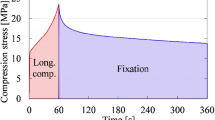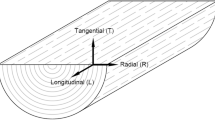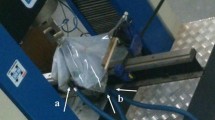Abstract
The enhanced ability of small wooden beams to deform under decreasing moisture content conditions when subjected to constant bending and torsional stresses, has been studied. Initially green samples of Eucalyptus grandis and Pinus sylvestris were used. The purpose of the study was to determine whether the increased deformation during desorption or drying conditions, as reported by other workers, could be used as an indicator of the instantaneous average moisture content. For both species, relative torsional and bending deformation (RTD and RBD) increased with decreasing moisture content and the deformation also increased with increasing temperature. In the case of E. grandis both RTD and RBD could be used to determine moisture content under drying conditions while for P. sylvestris the relationship between RBD and moisture content was more pronounced than that between RTD and moisture content.
Zusammenfassung
Die Eigenschaft kleiner Holzstäbe, sich unter konstanter Verdrehungs-und Biegebeanspruchung mit abnehmender Holzfeuchte zunehmend zu verformen, wurde untersucht. Hierzu wurden saftfrische Proben von Eukalyptus grandis und Pinus silvestris verwendet. Ziel der Arbeit war es zu prüfen, ob die verstärkte Verformung bei Desorption oder Trocknung dazu benutzt werden kann, die augenblickliche Holzfeuchte zu bestimmen. Bei beiden Holzarten stieg die relative Verformung unter Verdrehung und Biegebeanspruchung mit abnehmender Holzfeuchte und mit steigender Temperatur. Im Falle von Eukalyptus grandis konnten beide Verformungen für die Bestimmung der Holzfeuchte unter Trocknungsbedingungen herangezogen werden. Bei Pinus silvestris war die Beziehung zwischen Holzfeuchte und der Durchbiegung unter Biegebeanspruchung ausgeprägter als bei der Torsionsverformung.
Similar content being viewed by others
Literature
Armstrong, L. D.; Kingston, R. S. T. 1960. Effect of moisture changes on creep in wood. Nature 185 (47/16):862–863
Armstrong, L. D.; Christensen, G. N. 1961. Influence of moisture changes on deformation of wood under stress. Nature 191 (4791):869–870
Armstrong, L. D.; Kingston, R. S. T. 1962: The effect of moisture content changes on the deformation of wood under stress. Aust. Ast. J. Appl. Sci. 13 (4):257–276
Armstrong, L. D. 1972. Deformation of wood in compression during moisture movement. Wood Sci. 5(2):81–86
Armstrong, L. D. 1983: Mechano-sorptive deformation in collapsible and non-collapsible species of wood. J. Inst. Wood Sci. 9 (5):206–211
Bariska, M. 1983: Zur dynamischen Torsionselastizität von Holz. Teil 1: Untersuchungen im Temperaturbereich von 23 bis 350°C. Holz Roh-Werkstoff 41:109–114
Bethe, E. 1969: Festigkeitseigenschaften von Bauholz bei Lagerung in Wechselklima unter gleichzeitiger mechanischer Belastung. Holz Roh-Werkstoff 27 (8):291–303
Christensen, G. N. 1962: The use of small specimens for studying the effect of moisture content changes on the deformation of wood under load. Aust. J. Appl. Sci. 13 (4):242–256
Eriksson, L.; Norén, B. 1965: Der Einfluß von Feuchtigkeitsänderungen auf die Verformung von Holz bei Zug in Faserrichtung. Holz Roh-Werkstoff 23:201–209
Hearmon, R. F. S.: Paton, J. M. 1964: Moisture content changes and creep of wood. For. Prod. J. Aug. 357–359
Leicester, R. H. 1971: A rheological model for mechano-sorptive deflections of beams. Wood Sci. Technol. 5:211–220
Scharr, G. 1986: Beitrag zur Torsionselastizität von Hölzern in Abhängigkeit von der Holztemperatur und der belastungszeit. Holz Roh-Werkstoff 44:57–60
Schwab, E.; Polaczek, P. 1977: Bestimmung der Schubmoduln von Holz durch statische Torsionsversuche—Beitrag zur Neufassung DIN 52190. Holz Roh-Werkstoff 35:23–27
Author information
Authors and Affiliations
Additional information
This paper is dedicated to Prof. Dr. H. Schulz, Head of the “Institut für Holzforschung der Universität München” where the research was carried out during the second half of 1988. The financial assistance of the Alexander von Humboldt Foundation (Germany), as well as of the Merensky Foundation, CSIR and “Grantin-Aid” is gratefully acknowledged
Rights and permissions
About this article
Cite this article
Vermaas, H.F. Mechano-sorptive behaviour of wood and its use for moisture content determination. Holz als Roh-und Werkstoff 47, 471–477 (1989). https://doi.org/10.1007/BF02640145
Issue Date:
DOI: https://doi.org/10.1007/BF02640145




